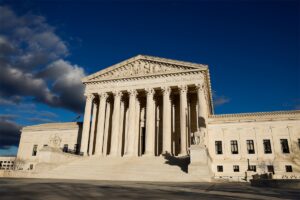In Corner Post, the Supreme Court will decide when federal regulations can be challenged

Taking the government to court
When the federal government takes an action that hurts you, you probably assume there is a legal remedy available—that you can challenge the government in court. And indeed, you can: Under the Administrative Procedure Act (APA) “[a] person suffering legal wrong because of agency action, or adversely affected or aggrieved by agency action within the meaning of a relevant statute, is entitled to judicial review thereof.” A court reviewing the agency action must decide whether it violates a law or the Constitution; if the answer is yes, the APA requires the court to set aside that action.
Basically, if you think the government acted wrongly and you are injured, you can ask a judge to take a look.
As is the case with most claims brought in court, a statute of limitations applies. Statutes of limitations prevent claims brought a certain period of time after an injury. So, for example, if you slip and fall on someone’s property, the law requires you to pursue your claim in court within a reasonable amount of time. Otherwise, the potential defendant in your case would have to wait indefinitely for you to sue, creating a cloud of uncertainty.
If an agency issues a new rule that affects you negatively, you can challenge it in court under the APA within six years of the rule’s publication. That’s a relatively lengthy period of time and sufficient for most regulated parties to decide if they want to litigate.
But what if you are being harmed by a government rule issued before you even existed? That is the situation in which a North Dakota truck stop finds itself.
What if you can NEVER sue?
Corner Post opened its doors as a truck stop and convenience store in North Dakota in 2018. Like most other businesses, it accepts debit card payments and pays a fee to the issuing bank on every such transaction. Until recently, that fee was set by card network companies (like Visa and Mastercard), which process the transactions. As part of the 2010 Dodd-Frank Act, Congress directed the Federal Reserve to cap the fee at an amount “reasonable and proportional to the cost incurred by the issuer.” In 2011, the Federal Reserve issued a rule limiting the fee that networks may charge to 21 cents per transaction plus 0.05% of the transaction’s value.
Since Corner Post first opened, it has paid hundreds of thousands of dollars in debit card fees. The owners of the truck stop argue the fee is not reasonable nor proportional to the banks’ costs. In 2021, Corner Post joined other organizations challenging the rule in an APA lawsuit against the Federal Reserve Board.
The government says Corner Post missed its chance to challenge the 2011 Federal Reserve Board regulation because the six-year statute of limitations ended in 2017. The lower courts in this case sided with the government, holding that even though the statute of limitations starts to run only when “the right of action first accrues,” that time period begins for everyone on the day a rule is promulgated—even if you didn’t come into existence until after the statute of limitations period had run!
Unfortunately, most other courts have agreed. One federal appellate court, however, took the commonsense approach that while “[t]he clock for the injured party begins to tick the moment the agency took its final action … that is not the case when … the party does not suffer any injury until after the agency’s final action” (Herr v. U.S. Forest Service).
With the circuit courts split on whether new parties injured by federal action can have their day in court, the Supreme Court granted review of Corner Post’s case and will hear oral argument on February 20, 2024.
What’s at stake
Many—even most—individuals and businesses suffer a legal wrong from a regulation at the time the government issues it. But for those who don’t yet exist or who aren’t immediately injured, Corner Post’s case is important and could make the difference between preventing the government from acting unlawfully or not getting beyond the courthouse door.
PLF and other public interest law firms often represent individuals and small businesses against the government for free. While our firm takes no position on the wisdom or legality of the debit card fee rule that Corner Post seeks to challenge, we do think that Corner Post—and other individuals and businesses that lacked the foresight to sue the government before they came into existence—should have a chance to make their arguments in court. Accordingly, PLF submitted an amicus brief showing that several of the government’s arguments don’t hold water.
Corner Post’s textual argument is strong. The six-year statute of limitations applicable to APA claims states that claims will be “barred unless the complaint is filed within six years after the right of action first accrues.” Typically, a claim accrues when the plaintiff has a right to commence it. When is a plaintiff entitled to seek judicial review of an agency action? Under the APA, it is when that person “suffer[s] legal wrong” because of that action or is “adversely affected or aggrieved” by it. So, the APA says (and the government will normally not miss an opportunity to argue) that a plaintiff who has not been hurt in some way by agency action cannot bring an APA challenge because the right of action has not yet accrued. Consequently, the statute of limitations cannot begin running before a plaintiff is injured.
The Federal Reserve Board points to numerous federal statutes that do specify that the time period within which a plaintiff can sue runs from the time of the government action. These are commonly referred to as statutes of repose, rather than statutes of limitations—if a specified amount of time has elapsed from the action, the defendant is no longer subject to suit, regardless of when a potential plaintiff is injured.
But the existence of such statutes hardly works in the government’s favor. Such examples demonstrate that Congress knows full well how to draft a filing period in the manner the government desires here, but intentionally did not do so. No doubt, Congress could decide the interest of finality trumps fairness to future litigants, but it is Congress that must make that decision, not the Executive Branch.
The government’s arguments about reliance interests and finality are also undercut by a simple fact: You can challenge a regulation at any time if you’re the subject of an enforcement action brought by the government itself. And PLF has spent years successfully persuading the Supreme Court to clarify and confirm that parties need not wait for the government to “drop the hammer” in an enforcement action to challenge the legality of the underlying law. The government’s argument is even less persuasive when, as in Corner Post’s case, the agency that issued the rule doesn’t actually enforce it. Corner Post does not even have the option to decline to pay the fee (which is deducted from the sale proceeds by the processor) and wait for the government to bring it to court.
PLF also pointed out that if newly injured plaintiffs can challenge a regulation only when they face enforcement, the uncertainties inherent in litigation could incentivize more expansive agency action: many, if not most, potential plaintiffs will simply choose to comply, reluctantly, rather than pay for and risk litigation, even against rules that are plainly invalid.
PLF’s brief also highlights the government’s many other means of evading judicial review of its regulations. In addition to the background standing, ripeness, and mootness doctrines that can limit plaintiffs’ ability to take the government to court, agencies frequently rely on APA-specific arguments to keep even meritorious claims out of court.
For example: PLF is representing Jake’s Fireworks, a Kansas-based company, in a lawsuit against the Consumer Product Safety Commission. The CPSC sent multiple notices to Jake’s, directing the company to destroy many of its fireworks and threatening millions of dollars in penalties for selling them. Jake’s has strong arguments that the CPSC is misapplying its own regulations, but the government has now twice succeeded in keeping Jake’s from making those arguments to a district court judge, arguing that those demand letters were not sufficiently “final” or, amazingly, were not agency action at all under the APA.
Without APA review for newly injured parties, a regulation that survives unchallenged beyond its sixth birthday can be insulated from review by an agency’s refusal to enforce it formally or government arguments that the enforcement actions it does take are not sufficiently “final.” Despite that peculiar outcome, most lower appellate courts have agreed with the government’s view, which means that—in most of the country—people who want to obtain judicial review of a federal regulation more than six years after it was issued are out of luck.
Judge Edith Jones expressed the core of the issue simply in a dissenting opinion, observing that “a regulation initially unauthorized by statute cannot become authorized by the mere passage of time.” (Dunn-McCampbell Royalty Interest, Inc. v. Nat’l Park Service). This truism supports Corner Post’s reading of the law. The Supreme Court should read the APA in light of its “basic presumption of judicial review,” (Abbott Labs v. Gardner), and hold that parties newly harmed by a regulation have an opportunity to challenge that law in a court.




